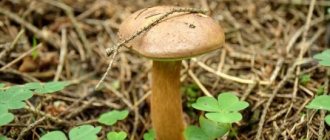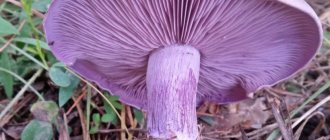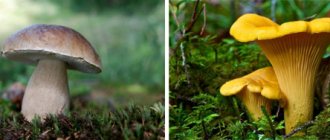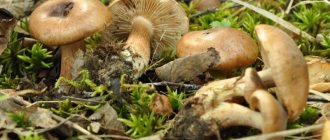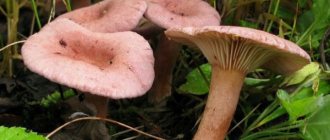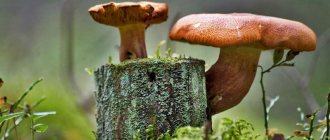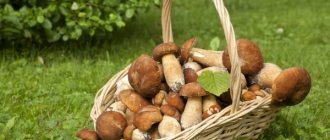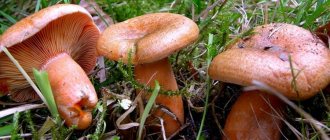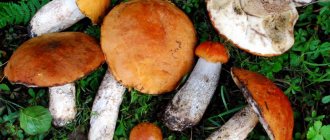- home
- Rest and leisure
- For mushroom pickers
Natalie
5
(3)
Reading time: 18 minutes
Ryzhik is a special mushroom, glorified by more than one generation of lovers of traditional Russian snacks. In terms of taste and nutritional value, it is not inferior to its noble white counterpart. The saffron mushrooms (pictured) do not need a description, but it is worth reminding of what is hidden behind the red cap, recognizable by millions.
Common camelina
This is probably one of the few mushrooms to which real literary odes are dedicated. In his work “The Seventh Hunt,” the talented, original writer and poet Vladimir Soloukhin literally declares his love for saffron milk caps, sparing no compliments and literary colors.
Excerpt from the work of V. Soloukhin “The Seventh Hunt”
After such a declaration of love, you just want to go to the store and buy yourself a couple of cans of salty food. However, real saffron milk caps are prepared only at home. Where and how to collect healthy mushrooms, how to distinguish real saffron milk caps from false ones, how to prepare and preserve them - the most accurate and verified information can always be found only on the portal agronom.guru.
Since ancient times, saffron milk caps in Rus' have been considered a “smuggled-export” product. A barrel of salted or pickled saffron milk caps, along with liqueurs and stronger drinks, was taken with them to important negotiations abroad by nobles of various ranks. It is no coincidence that the second name for saffron milk cap is the royal mushroom.
Classic wild mushroom marinade
- Why is the saffron mushroom called that?
- Description of the mushroom saffron cap The shape of the cap of the saffron milk cap
- The size of the leg of a saffron milk cap
- Spruce saffron milk cap
- How to salt
Description of the saffron mushroom
Family of saffron milk caps in a pine forest
The shape of the cap of a saffron milk cap
In order to correctly “identify” a mushroom, you should look at its cap. An “adult” mushroom can grow up to 15 cm in diameter. What does a red mushroom look like? In real saffron milk caps, the plates on the back of the cap always have a uniform orange color. When pressed, the place pressed first turns red, juice is released, which immediately acquires a greenish tint. If you cut the mushroom, the flesh is orange, but quickly oxidizes and also turns green.
True camelina plates
The shape of the camelina cap is usually flat, concave inward, the edges are slightly bent, the structure is smooth, slightly oily. The colors range from yellow to red-orange, and are characterized by cylindrical circles on the cap. Sometimes greenish-blue spots may appear on the cap when exposed to air.
Spruce saffron milk cap
The plates of saffron milk caps are usually slightly fused at first, and descending toward the stem. They always change shade when pressed to brown or green.
The size of the leg of a saffron milk cap
The leg is tubular and crumbles easily. Usually short, sometimes covered with fluff. Dense at the point of attachment to the cap, then hollow.
Useful properties and composition
Calcium, phosphorus, potassium, vitamins A and B (riboflavin, thiamine and niacin), beneficial amino acids, anti-inflammatory and antibacterial substances - they are all contained in camelina.
The exact ratio of minerals in camelina: potassium - 397 mg, calcium - 9 mg, phosphorus - 166 mg.
The fungus contains fungin, a biologically active substance that stimulates the production of gastric juice. That is why people suffering from gastrointestinal diseases such as pancreatitis, gastritis, and stomach ulcers should stop eating saffron milk caps.
Saffron milk caps can replace a full meal
100 g of dried saffron milk caps will completely cover the daily need of the human body for meat.
Salted saffron milk cap is one of the most easily digestible foods and is superior in calories to beef and chicken.
What effect does the mushroom have on the human body?
- Increases performance and endurance. The mushroom contains a large amount of ascorbic acid, which has a tonic effect on the body.
- Creates strong bone tissue. The combination of three “building elements” of the skeleton and bones at once - phosphorus, calcium and potassium - significantly improves the condition of nails, bones and teeth.
- Antibacterial . The mushroom is saturated with a substance such as lactriviolin, a natural antibiotic that can fight such a serious infection as tuberculosis. It is from mushrooms that this substance is artificially obtained and used in the production of medicines against Koch's bacillus.
- Restores metabolic processes. Used in the treatment of skin spotting (vitiligo), rheumatism, pneumonia.
- Antitumor effect . When consumed regularly, organic saffron milk caps prevent the occurrence of cancer in the body.
Spruce saffron milk cap In addition to its high nutritional value - saffron milk caps are considered to be the highest type of mushroom in terms of usefulness and composition, they have another very significant advantage, most often it is a pure mushroom, without rot and soil, especially if it is collected after rain early in the morning. There is no need to soak it before processing, just rinse it.
Application
Types of saffron mushrooms are widely used in various fields.
In cooking
Mushrooms are used:
- fresh: to do this, they are doused with boiling water, without processing they become bitter;
- for frying;
- extinguishing;
- pickling;
- pickles;
- for freezing.
They are prepared with potatoes, added to okroshka, salads, served as a cold dish, or as a sauce for meat. They have a rich taste and are not bitter when cooked correctly.
You can freeze mushrooms after pre-treatment. They should be cleaned, washed, but not soaked; the wormy ones must be thrown away.
Roasted mushrooms make delicious dishes
In medicine
The category of these mushrooms treats:
- rheumatism;
- tuberculosis;
- metabolic disorders;
- vitiligo;
- skin diseases.
Saffron milk caps are used for insect bites. They are applied fresh to bite sites, for joint pain, and boils.
They are great for weight loss, are a low-calorie product, and are easily digestible.
Where do saffron mushrooms grow?
Under what trees does saffron milk grow? You should look for “ryadovik” (another popular name for saffron milk cap) in the immediate vicinity of a pine or spruce tree; the mushroom especially loves young growth of pine trees. Most willingly, it “settles” on the edges and hills with short grass. Most often found in mixed coniferous forests of the Urals and Siberia.
The native home of the saffron milk cap is coniferous forests
True saffron milk cap always grows in “colonies”. Rest assured, if you have collected one mushroom, there is probably another one hiding next to the grass.
Main types of saffron milk caps
We have found out where the saffron mushroom grows, now let’s see what it is like. According to the place of growth, there are two main varieties of camelina - spruce and pine.
Spruce saffron milk cap
Grows in spruce forests. This variety is a medium-sized mushroom - from 2 to 8 cm. The older the mushroom becomes, the deeper the “funnel” on the cap.
Elovik
The edges of this mushroom are not curved, the stem is short. In damp weather, greenish mucus accumulates in the cap - this is a reaction of the fungal substances with the environment. Unlike the classic saffron milk cap, a much lighter yellow-gray, rarely orange, hue, the circles are barely noticeable. The taste of spruce is a little bitter.
The saffron milk caps are real
The saffron milk cap is real.
Such a “masterpiece” is difficult to miss. It looks like it was written from a picture. It is distinguished by a beautiful shiny cap in rich colors - from orange and brown to red-brown. The stem is dense, the color of the cap is even, bright red, it is slightly rounded at the edges. Grows in pine forests. Such mushrooms, as a rule, are immediately used entirely in pickles and marinades. However, to detect it, you will have to carefully examine each tubercle. The real saffron milk cap hides under a thick layer of grass and leaves. The latest mushroom of all saffron milk caps - it is collected until the end of autumn.
Red saffron mushroom
Red saffron milk cap
Not the most popular type of saffron milk cap. It is found almost in impenetrable coniferous forests. It differs in that it does not contain the mucus or milky juice familiar to other types of mushroom. It's practically dry. The leg is also different; it looks like it is covered with flour and has red spots. Quite brittle.
False saffron milk cap
Mushroom pickers insist - there are simply no false mushrooms! There are other types of mushrooms that are very similar to saffron milk caps, some of them are inedible and dangerous!
The real edible saffron mushroom exudes a pleasant smell of fresh resin in places where it breaks.
However, if you look at them more closely, they have nothing in common with real saffron milk caps.
- Inedible mushroom. It is also called amber milky. The main difference from the saffron milk cap is the leg. It is usually long, hollow and white in color. And we remember that a real saffron milk cap is usually the same color as its cap, and its stem is hollow.
Amber milkweed is an inedible mushroom, very similar to saffron milk cap. - Death cap. It is quite easy to confuse it with a saffron milk cap - their caps are similar, but the toadstool's leg has a characteristic skirt, which a real saffron milk cap does not have.
The dangerous double of the saffron milk cap is the ubiquitous grebe - Volnushka. The most harmless representative in this group. Volnushka does not pose any threat. However, it is still worth knowing about the difference. The edges of the waves are more rounded, in addition, they are covered with a small fluff.
Volnushka pink
You can accurately check whether a mushroom belongs to a noble family by cutting it off - if after some time the cut site turns blue or dark green, then it is a camelina.
Pine mushroom
It grows only in pine forests. Usually attached to trees or growing close to the rhizome. Unlike other varieties of saffron milk cap, it often grows alone. A characteristic feature is that they like to hide under branches or a thick layer of grass. The circles spread out in wider waves and are often uneven, oval-shaped, or even discontinuous.
The boletus mushroom loves to hide - it is better to look for it directly under the pine trees, in the grass
In the dry season there are more pine mushrooms, in rainy summers there are more spruce mushrooms.
Camelina milky red
Two-colored camelina
Thanks to its specific color, the camelina has a rather noticeable appearance. It lives in coniferous forests and ripens in late autumn. Sometimes green is also added to orange-red colors. Otherwise, it has all the other properties characteristic of saffron milk caps.
Collection rules
Rizhik grows near young pines, in young spruce forests, in mixed forests, in dense short grass and among mosses. These mushrooms prefer dimly lit clearings with sandy soil. The spruce species grows more often in coniferous forests, while the pine species can grow near a lonely tree and even in a city park.
For your information!
The “silent hunting” season for saffron milk caps begins in June, but the main harvest of these mushrooms is August-September.
You can determine when to collect these mushrooms using folk signs:
- If wild raspberry berries are ripe and porcini mushrooms of the “second wave” appear, then after 20 days you can start picking.
- They appear in the fall in the place where boletus grew in the summer.
- The heather is blooming - the time for saffron milk caps has begun.
Collecting saffron milk caps
This tasty mushroom is loved by mushroom worms, so you need to collect it in the morning. Shiny with dew, it is better visible in grass and pine needles. In order not to lose a significant part of the harvest, mushroom pickers often process this delicate mushroom immediately after harvest, sprinkling it with salt in containers brought to the forest.
Interesting!
The most favorable temperature for mushroom growth is +10-12°C. After the first frost they stop growing. A rich harvest occurs every three years.
How to cook saffron mushrooms
Most often, saffron milk caps are salted or pickled. Before freezing, some mushroom pickers lightly sauté mushrooms to get rid of parasites and bacteria. The bravest summer residents even eat raw saffron milk caps, lightly sprinkled with salt.
How to salt
There are two ways to pickle saffron milk mushrooms. Consider the option of cold pickling of mushrooms.
| Photo | Description |
| To prevent the saffron milk caps from losing their beautiful color after salting and turning green, they are doused with boiling water; the steam will also kill germs. | |
| Salting of mushrooms occurs in layers - a layer of saffron milk caps, a layer of salt, and so on in turn. We take salt at the rate of 50 g of salt per 1 kg of mushroom mass. | |
| In fact, we achieve a thin, uniform layer of salt at each “level.” | |
| Before laying the first and after the last layer, you can continue the mushrooms with bay leaves and allspice. But remember, such a seasoning can completely take away the pleasant pine flavor of mushrooms. | |
| After laying the last layer, the salty mass is covered with a plate and the load is placed. Leave to cure for 4 or 5 days. | |
| After which our salted saffron milk caps are ready! |
The method is cold. This method is suitable when you are sure that your “catch” is 100% safe. In this case, heat treatment with boiling water is not allowed. The mushrooms are sorted, washed and simply covered with salt without water. In this case, scalding is prohibited, no heat treatment occurs, the mushrooms are simply rinsed, cleared of debris, and the stems are lightly trimmed. Place in a bowl with the caps down.
Saffron milk caps give juice literally after 12 hours after adding salt.
The layer should be approximately 5-8 cm wide. We traditionally sprinkle each layer with salt. Next we put oppression. After a couple of days, the mushrooms will give juice and marinate in this jelly-like mass. The consistency can be considered ready if it has been salted for at least a month.
Once upon a time there were so many saffron milk caps in the Ural forests that they were salted right there. Special cedar barrels were taken into the forest, the mushrooms were washed in the river, wiped dry, and sprinkled with salt.
How to marinate
Pickled saffron milk caps are a product of amazing taste!
Mushrooms are selected as usual, washed, the stems are cleaned, only the caps can be pickled. The prepared mushroom mass is poured with salted boiling water. Leave covered for 3 minutes. Drain in a colander, cool, and place in jars.
The next step is preparing the marinade. We take water at the rate of three-quarters of a glass per kilogram of mushrooms, add salt, spices and boil with reduced heat after boiling for about half an hour. After the marinade has cooled, add 8% vinegar, about half a glass. Pour the mixture over the mushrooms, close the jars, and place in a cool place.
Jars with saffron milk caps must be stored in a cool room with a temperature of about +15°C
Salted and pickled mushrooms love coolness. It is best to put the jars in a cellar or basement. It is necessary to check banks periodically.
How to freeze
Saffron milk caps are an excellent raw material for freezing. Moreover, you can freeze both fresh, dried and lightly fried mushrooms. The main task before freezing is to get rid of potential parasites and bacteria. How to prepare saffron milk caps for freezing? Suitable for boiling, drying or frying. As a last resort, you can wash the raw materials and pour boiling water over them. But in any case, it is important that the saffron milk caps get rid of excess moisture. For freezing, use regular bags. It is better to package the mushrooms in smaller bags in order to use exactly the quantity and volume that is needed.
Growing methods
To grow, it is worth reproducing the conditions in which saffron milk caps usually grow in the forest. It is recommended to plant them in the ground under pine and spruce.
Method 1. Fungal spores
The caps of old mushrooms collected in the forest are finely chopped, dried, scattered above the ground with moisture, covered with soil on top, and watered.
Method 2. Alternative, with fungal spores
Caps with sugar are poured with water, after 24 hours they are softened. Next, this entire mixture is poured onto the seat. A thin layer of soil is poured on top.
Method 3. Planting mycelium
This method consists of planting ready-made mycelium. Mycelium can be ordered from a store or dug up in the forest yourself. There is ready-made mycelium on sale, as well as blocks of porcini mushrooms, which make an excellent tubular harvest of boletus mushrooms.
For the second option, take a 21x21 cm layer around the mushroom body and plant it immediately. The planting site should be similar to the original one in the wild and constant watering is required. The harvest grows the next year.
